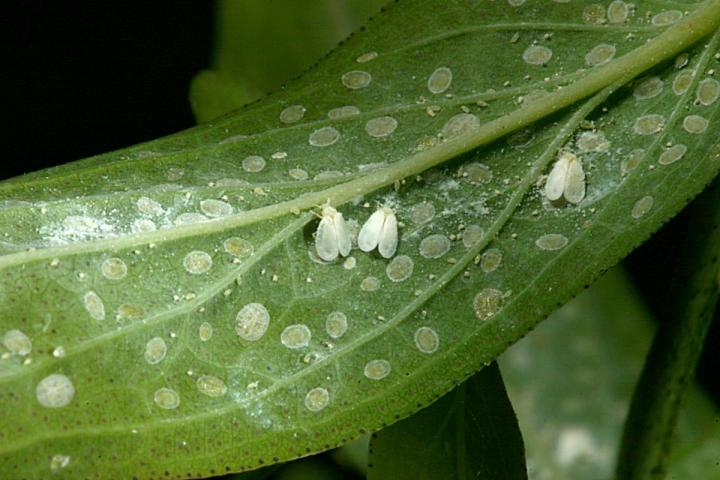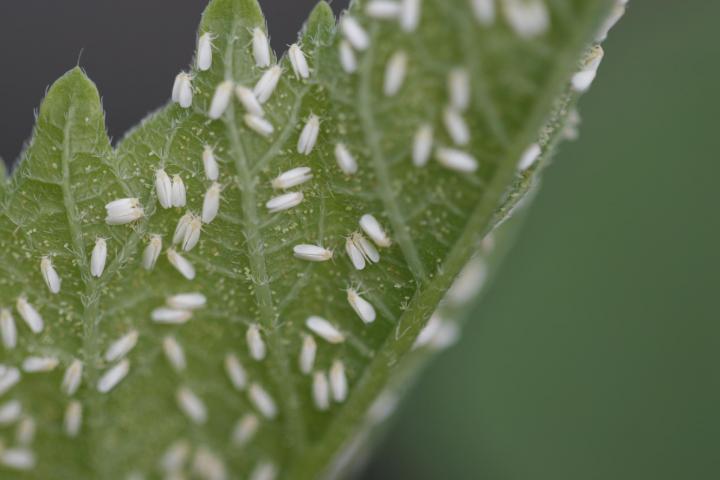






Whiteflies and their small, oval nymphs reside on the undersides of leaves and cause the leaves to become sticky with honeydew.
The Ohio State UniversityHere are tips on how to identify, control, and get rid of whiteflies.
What are those little white flying bugs on your plants?
Whiteflies, also known as aleyrodidae, are soft-bodied, winged insects closely related to aphids and mealybugs. They can be found in most any region, but they are so tiny that they are usually camouflaged.
They can be as small as 1/12 of an inch, somewhat triangular in shape, and are often found in clusters on the undersides of leaves. They are active during the daytime, so they are easier to spot than some other nocturnal pests. Whiteflies are capable of over wintering and reproducing throughout the year in warmer climates.
One common species of whitefly is the silverleaf whitefly, which is slightly smaller and more yellow than other whiteflies. Silverleaf whiteflies are especially common in southeastern states. All species of whiteflies affect a wide variety of plants.
You’ll often see whiteflies in mid- to late-summer when it gets warm; they are also a common pest in greenhouses.
Whiteflies tend to suck on ornamentals and warm-weather vegetable plants, including tomatoes, eggplant, peppers, and okra. They also like sweet potatoes and plants from the cabbage family.
Whiteflies suck plant juices and, in turn, produce a sticky substance known as honeydew. Honeydew left on its own can cause fungal diseases to form on leaves.
Due to whitefly feeding, plants will quickly become extremely weak and may be unable to carry out photosynthesis. Leaves will wilt, turn pale or yellow, and growth will be stunted.
Honeydew is a sign that the whiteflies have been feeding for several days and you might also see ants, which are attracted to the honeydew.
Check undersides of leaves around the veins for white insects, even if they aren’t visible, and feel leaf surfaces for honeydew. If the whiteflies are feeding, they’ll suddenly all fly off the leaves in a swarm, so it’s very obvious.
You may also find eggs also laid on the undersides of leaves. This is the beginning of a new generation! When the eggs hatch, the larvae will look like teeny white ovals without legs; they don’t move but they immediately start sucking the plant juice. This is why gardeners miss the whiteflies until it’s too late. Adult females can produce up to 400 eggs, which can hatch in between one week and a month. They are usually laid in a circular pattern. Eggs are pale yellow when newly laid and brown when about to hatch.

To control whiteflies, there are various solutions and traps that you can use. The biggest tip is: start early! In the mornings and evenings, as you wander the garden, check the back of the leaves for eggs or notice when little bugs “fly away” as you approach your plants.
How to Identify and Get Rid of Aphids
Cabbage Worms: How to Identify and Get Rid of Cabbageworms
Flea Beetles: How to Identify and Get Rid of Flea Beetles
Squash Bugs: How to Identify and Control Garden Pests
Moles: How to Identify and Get Rid of Moles in the Garden or Yard
Copyright © www.100flowers.win Botanic Garden All Rights Reserved